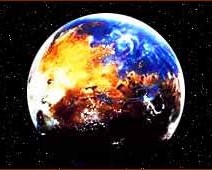 |
| What We Know About the Red Planet | ||||
| History | Water | Ice | Air | Canals |
| Seasons | Mountains | Rocks | SandDunes | Rift Valley |
| Moons | Dust Storms | Stats | Closest | Kid Pix |
| Lunar | Movies | Life Search | Wanted | Exploring Mars |
The popular notion of channels on the Red Planet:
Finding the Canals of Mars
Mars is a small planet never closer to the Earth than 35 million miles (56 million kilometers). That makes it difficult to see surface details.
Resolving surface features in a telescope image is even more of a problem because of the blurring effects of two atmospheres, Earth's and Mars'.
An example of confusion about Mars is found in the famous canals on Mars, They reportedly were first observed by Italian priest Pietro Secchi in 1876. Then Giovanni Schiaparelli published a map of Mars in 1877. He assigned names to bright and dark features which included a large number of straight-line features that Schiaparelli and Secchi called "canali." The mistranslation in English-speaking countries of "canali" into "canal," instead of the correct "channel," brought a misleading connotation of artificial construction by Martians that had not been intended by Schiaparelli and Secchi.
The popular notion that Martian canals had been constructed by an heroic, intelligent race tapping melting polar ice for water to irrigate equatorial crops was argued persuasively by the famous astronomer Percival Lowell in his 1895 book. Not everyone agreed with the canal theory, but the idea of Mars supporting life became established and persists today.
Why Is It Called the Red Planet?
No other world has tickled the human fancy more than Mars. It seems nothing in Outer Space fires the imagination more than the Red Planet.
Ancient Romans surely didn't know much about Mars, except it was a planet and it was red. They saw it as an angry light in the heavens worthy of the name of their mythical god of war.
Today, we still call Mars the Red Planet because it is easily distinguished in the night sky by its reddish color which comes from rusty sand and rocks that cover the Martian surface.
Learn more: Human Exploration of Mars:
There have been three stages of exploration so farFlybys:
Probes fly by Mars taking pictures Orbiters:
Spacecraft fly into orbit above MarsLanders and Rovers:
- Orbiters
- Mariner 8-9
- Viking 1-2
- Mars Observer
- Mars Climate Orbiter
- Mars Global Surveyor
- Mars Global Surveyor home
- 2001 Mars Odyssey
- 2001 Mars Odyssey home
- Mars Express
- Mars Express home
- Mars Reconnaissance Orbiter 2005
- Mars Reconnaissance Orbiter home
Landers and rovers drop to the surfaceSand dunes: Dust Storms: Air: Carbon Dioxide: Outflow Channels: Valley Networks: Rift Valley: Ice: Ice caps: Frost: Water: Artesian Water: Mars Weather: Mars Photo Galleries: Planet features: Canals: Rocks: Mountains: Dating and aging: Seasons:
